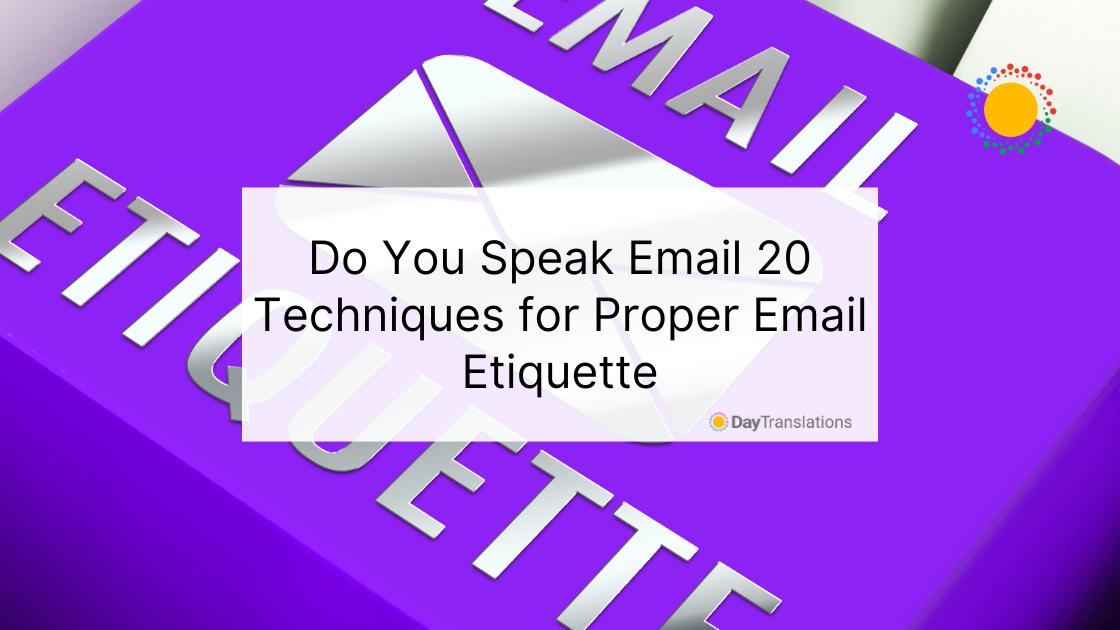Outside of calls and text messages, email is the most commonly used means of communication. Email is used formally and informally by individuals, organizations and corporations. It is a cheaper and faster way to send longer and detailed messages anywhere in the world that has Internet service.
A significant part of a person’s workday is taken by email. Many people depend on email for their work processes, as the platform allows the user to attach different types of documents, presentations, photos, artworks, static and animated graphics, audio and videos in different formats.
While sending and receiving email is already a part of the daily work and life routine, it is still essential to understand that there is email etiquette that you should keep in mind.
Email etiquette
People have become so used to sending and receiving emails that they may have forgotten the rules of common courtesy that is attached to any means of communication. Since email is written and can be stored, it will be hard to deny if there are errors in the message, so aside from the courtesies, it is also vital to be careful when sending and replying to emails. Here are some of the rules you have to remember.
1. Ensure the subject line is clear
You have to keep in mind that most people receive emails each day, so for your email to be noticed easily, see to it that the subject line of your email is very clear. For example, if you are sending a financial report for the first quarter, mention it in the subject line.
2. Include your signature
Configure your email so that your email signature is automatically included in every email you send, especially if it is a business mail. It should include your name and contact information, such as your phone number and address.
3. Use professional greeting or salutation
Even if you have a close relationship with a person, when it comes to email salutation or greeting, it is still better to use the hello or hi, instead of yo, hey or hiya, that are considered unprofessional. For formal emails, you can use Dear and the recipient’s given name if you are on first name terms with the recipient. If not, use the formal title, such as Dear Doctor Jones. Remember that the name should not be shortened unless the person gives you permission.
4. Introduce yourself briefly
If you are sending a confirmation email or a proposal after meeting with a client, be sure you follow the standard protocol. Do not assume that the client remembers you. Introduce yourself briefly. Include a brief summary regarding your meeting and the agreements you have made. Give a brief information about the proposal you are attaching and as well as other details. Include your name, email address, company address and contact information.
5. Humor should be avoided
When sending business communication via email, see to it that you avoid humor. First, humor is not applicable to business email, which is formal communication. Second, it does not translate well, since it is may give the wrong connotation. It may be misconstrued as sarcasm due to the absence of facial expressions and vocal tone.
6. Always proofread your message
When sending a formal email, be sure to proofread it. Do not think that it is “just” an email. You are judged by the manner you compose your message. If there are grammatical errors and misspelled words, you can be seen as a careless and sloppy person. Or worse, you might be labeled as uneducated. See to it that before you hit the send button, you check your message for errors. There are grammar and spelling checkers that you can install as an added feature to your email program, which can greatly help you in composing your email messages.
7. Don’t presume that the recipient knows the subject matter
Keep in mind that the email recipient receives and reads a number of emails each day. So, it is important that each email you send is a stand-alone message. Include the subject matter in the mail and other references to past emails, conversations or research. It is difficult to look for past emails so adding the reference or previous conversations will greatly help the reader. In some cases, you can reply through the message thread.
8. Reply to all emails
It is considered polite to reply to all legitimate or recognized emails that you have received, even if it is a short one. You can acknowledge receipt of the email. A modern email platform today has standard replies that you can just click and send. If you received an email that was erroneously sent to you, you must inform the sender.
9. Take time before responding to an email that made you angry
If you received an email that made you angry, give some time for your emotions to settle down before composing a reply. It will help you compose the right response when you’ve had time to calm down. See to it that you review your message a few times to ensure that your response is not emotionally laden.
10. Protect your privacy
It is very easy to forward email messages. So, see to it that the emails you are sharing with your friends do not contain confidential or personal material. If you want to share some information, you can always call your friends or show the email when you have the chance. If you want to share a personal email, ensure that you ask permission from the person who sent the message to you.
11. Avoid too many exclamation points
Even if you are excited after receiving some good news from your client, showing your excitement by using capital letters, exclamation points and informal abbreviations and emoticons has no place in business communication. Express your excitement and thanks using the appropriate words without adding several exclamation points or capital letters.
12. Ensure that you are only discussing public topics
As mentioned earlier, it is very easy to share emails, so ensure that you are only discussing public topics, especially in inter-office email system. Remember that there were several cases where private emails were shared throughout the company and later with the rest of the world. See to it that you protect yours or someone else’s privacy and the confidentiality of sensitive documents by being aware of the subject matter and who should be receiving your email.
13. Keep your email clean
Ensure that only the names of the main email recipient/s are in the ”To” line. If the email is to be shared with other people, use the CC or BCC feature of the email platform. If you’re pasting a part of a previous email, see to it that you remove the carets. If you are forwarding the email to another person, delete the other email addresses. In the same vein, if you are replying to a particular person in the email loop, delete the rest of the email address. Do not click “Reply to all” if that is not your intention.
14. Avoid being labeled as Spam
Have you noticed that some emails you have received request that you whitelist them? In the same manner, avoid your email from being mistaken as spam by refraining from typing subject lines that are in all lower or upper case (all caps) or those that have exclamation points and URLs.
15. Match your subject line to the content of the email
It is easier to just reply to an email message through the email thread. But if the subject matter has changed, see to it that you create a new email or change the subject line of the thread.
16. Limit the number of attachments in a single email
Be courteous to the email recipient by sending only two attachments to your email. Do not assume that the recipient has fast Internet connection or that the email platform the person uses is capable of receiving large files.
17. Take care of sending large files
Corollary to item #16, it is better to ask the recipient if it is all right to send a large file. Remember that sending a large attachment can clog the inbox of the receiver and some of their emails may bounce. If possible, use a large file sharing system and send the download link to the email receiver.
18. Keep it short and to the point
Keep in mind that the email recipient is busy, so ensure that your email is short and to the point. Compose a concise email, using bullet points when necessary to make the content easy to read and understand. You do not have to write several paragraphs to explain what you want to convey. If the subject matter needs a longer discussion, it is better to arrange a meeting or give the person a call.
19. Know the email recipient
Write the email with the recipient in mind. Adjust the level of formality and respect to the person receiving the mail. If the person tends to be formal and polite, be sure that you write in the same vein. If the receiver is relaxed and informal, suit your email language to the receiver’s level of formality.
20. Edit your replies
It is important to read the email thoroughly and reply to the email point by point. Doing so shows the sender that you have understood the email. It also a way to avoid misunderstandings and promote progress in the communication.
Following email etiquette shows your respect and courteousness to the receiver/s of your email. Remembers that your email reflects your personality. It can build or downgrade your reputation. You can be labeled as disorganized, careless or scattered if your email is full of mistakes and grammatical errors. It may take time to follow email etiquette but in the long run, it can keep your emails to the point and professionally done, making you look organized and polished.
Professional business translations
Day Translations, Inc. offers email translations and other business translation services. With Day Translations, you can be sure that your business translations are accurate and done by professional translators who are native speakers. Whenever you need translation services, day or night and wherever you are, give us a call, because we speak your language. We are open 24/7, every day of the year, so there is no waiting time when you order business translations with us. You can quickly get in touch with us through 1-800-969-6853 or send us an email at Contact us.












Sorry, the comment form is closed at this time.